Last Updated on July 21, 2025 by Hayk Saakian
Running a restoration business in 2025 isn’t just about drying drywall and sealing crawlspaces. You’re juggling insurance paperwork, technician schedules, moisture logs, and customer calls, often all before lunch. If you’re still managing all that with spreadsheets and sticky notes, it’s no wonder your day feels like a sprint through a hurricane.
And here’s the kicker: the global water damage restoration market is projected to reach $11.14 billion by 2025 thanks to rising storms, flooding, and old infrastructure woes (Inquirly). That kind of market size demands systems that actually work like a full-featured restoration CRM.
We’ve reviewed 8 top CRM platforms designed for mold remediation and water damage restoration companies, from industry giants like Dash and PSA to flexible tools like JobNimbus. You’ll get a side-by-side breakdown, pros and cons, pricing insights, and insights that pair well with what we covered in our restoration industry trends for 2025 blog.
Because let’s face it: “winging it” isn’t a business strategy anymore.
What Is a Restoration CRM?

A restoration CRM is software built to help you manage every moving part of your mold remediation or water damage business, without the chaos. Think of it as your digital job captain: tracking leads, scheduling teams, documenting jobs, and keeping insurance paperwork from swallowing your soul.
Now, you might be thinking, “Can’t I just use something like Salesforce or Monday.com?” Sure, if you enjoy duct-taping together tools and spending your evenings chasing signatures and moisture logs. But CRM for restoration companies is different. It’s built for the mess, literally. Field notes, drying logs, before-and-after photos, Xactimate syncs, claim statuses, it all lives in one place.
The best platforms, like the ones reviewed below, are designed specifically for mold remediation and water damage restoration CRM needs. They let field techs snap photos and upload notes from the job site while office admins pull compliance reports and update claims in real time.
If you’re still piecing everything together with spreadsheets and whiteboards, you’re not managing your business, your business is managing you. And you’re not alone, over 52% of field service businesses are already using purpose-built platforms, and that number is expected to hit 70% by 2025 (ProValet.io).
As job volume grows and customers expect speed, CRMs for restoration companies aren’t a nice-to-have anymore. They’re the only way to scale without burning out your team.
Why Restoration Businesses Need CRM Software in 2025
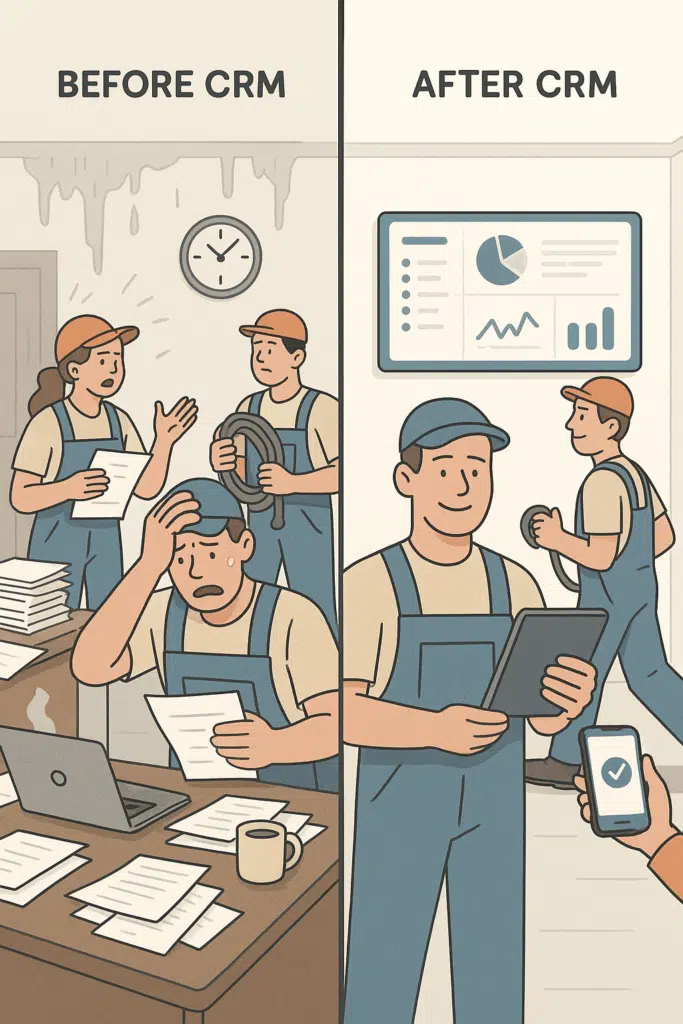
Let’s be honest, running a restoration company in 2025 feels like playing whack-a-mole with wet paperwork. One minute you’re chasing down an adjuster, the next you’re wondering if your tech remembered to snap job-site photos. Meanwhile, three jobs are behind schedule and someone just double-booked the dehumidifiers.
Sound familiar?
That’s exactly why a restoration CRM isn’t just helpful, it’s essential. Whether you’re managing storm surge claims in Washington or crawlspace mold in Oregon, the right system can keep your operations from unraveling.
A modern CRM for mold remediation helps you capture every detail on-site: moisture levels, photos, signed forms, and job notes all from your tech’s phone. For water damage restoration jobs, a CRM ensures you’re not digging through inboxes or text threads to find out where a crew is or what’s been billed. It centralizes your data, your people, and your process.
And let’s not forget compliance. In 2025, insurers expect documentation to be airtight. According to Cleanfax’s latest industry report, restoration firms face growing pressure from labor shortages, equipment gaps, and poor competition, making software-driven systems more critical than ever. One missed photo or missing timestamp can delay a payout for weeks. A good mold remediation CRM software doesn’t just organize your jobs, it protects your revenue.
If you’re still using pen-and-paper, you’re not just slow, you’re invisible to the systems that matter. A water damage CRM platform integrates with tools like Xactimate, QuickBooks, and photo documentation apps. That means faster approvals, fewer mistakes, and happier clients. And as Bainbridge Insights notes in its 2025 restoration outlook, companies embracing technology like CRM and automation outperform peers on every operational front.
We’ve helped hundreds of teams navigate this shift through tech + marketing support. If your system is still a whiteboard, you’ll want to check out our water damage restoration guide for practical, field-tested steps to improve job flow.
Ready to Streamline Your Workflow?
Restoration CRM Comparison
Next Gear Solutions (Dash)

If your restoration team is running more jobs than your whiteboard can handle, Dash might be your next hire, minus the coffee breaks. Built by Next Gear Solutions, this is one of the most recognized names in the restoration CRM software space, and for good reason. It was made for restoration professionals, not repurposed from some generic sales tool. You can also browse verified user reviews on G2 to see how Dash stacks up against other restoration platforms in the real world.
Dash supports everything from job intake to claim close-out. It’s loaded with features like real-time equipment tracking, automated task notifications, and a tight integration with Xactimate/XactAnalysis, which is gold if your revenue depends on insurance work. That makes it a strong contender for companies looking for CRM software for water damage restoration or mold remediation, especially those handling a high volume of insurance claims.
But let’s be clear, Dash is no plug-and-play solution. This platform’s power comes with complexity. If your techs barely survive logging into email, expect a learning curve. It’s also not the cheapest option out there, but restoration companies doing $1M+ in revenue will likely see ROI through time savings and claim accuracy.

Source: CoreLogic Next Gear
Key Features:
- Seamless integration with Xactimate and XactAnalysis
- Field-to-office document syncing (photos, moisture logs, signed forms)
- Workflow automation: trigger alerts, tasks, and job updates
- Equipment tracking and compliance reporting in one place
Pros:
- Built specifically as a CRM for restoration companies
- Robust documentation workflows to protect revenue
- Ideal for enterprise-level teams and insurance-heavy operations
Cons:
- Requires hands-on onboarding and staff training
- Higher upfront cost for licensing and implementation
- Overkill for smaller or cash-based restoration companies
Ratings:
- Price: 3/5
- Usability:3/5
- Features: 5/5
Is Dash the right fit for you? If your team handles complex insurance workflows or multi-crew job coordination, especially in fast-moving environments like Washington, Dash can bring much-needed structure to the storm.
For a deeper dive into building systems around tools like Dash, we’ve broken down proven strategies in our restoration marketing guide.
Albiware
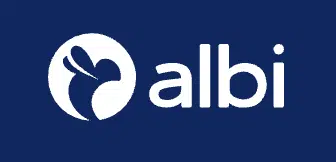
If your restoration team is still bouncing between spreadsheets, text messages, and whiteboards, Albiware is the kind of upgrade that feels like switching from a flip phone to an iPhone. This platform was built with restoration businesses in mind, not repurposed from sales software or wrapped in generic contractor lingo.
Albiware stands out as one of the more intuitive platforms in the restoration CRM space. Its modern, mobile-first interface is designed for real-world use, meaning your field techs can document a job, upload photos, and move on while the office sees updates in real time. It’s especially handy for mold remediation teams juggling fast-paced, high-detail jobs.
The drag-and-drop scheduling dashboard makes job assignment easy, while the CRM features keep leads, customers, and subcontractors in one place. And the workflow automation? A lifesaver. Instead of nagging your team about job status updates or follow-ups, the system handles it for you. It also supports content marketing by giving your team better visibility into lead flow and job status, the kind of clarity that helps marketing and ops work together.
You can also explore independent reviews and feature comparisons, where Albiware scores well for user-friendliness and integration capabilities
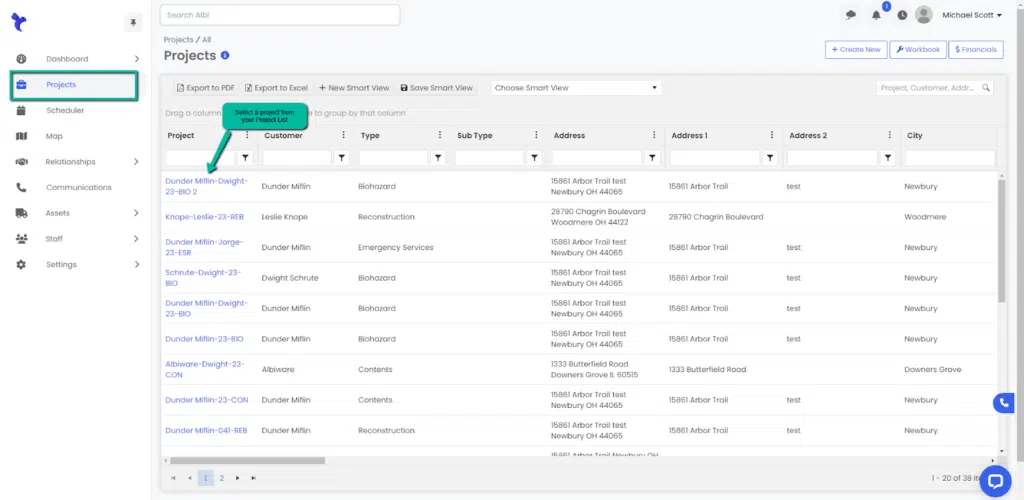
Source: Albiware
Key Features:
- Visual dashboard for scheduling and job status tracking
- Mobile app designed for field documentation and communication
- Built-in CRM to manage leads, adjusters, and customers
- Integration-ready (QuickBooks, Encircle, Zapier, and more)
- Custom workflows and automated notifications
Pros:
- Great balance of simplicity and power
- Built for restoration pros, not adapted from other trades
- Quick onboarding compared to most other restoration CRM software
- Solid choice for teams scaling from small to mid-size operations
Cons:
- May need workarounds for advanced compliance tracking
- Integration add-ons can push up the price if you scale fast
- Some deeper enterprise-level features still catching up to larger platforms
Ratings:
- Price: 4/5
- Usability: 4/5
- Features: 4/5
Is Albiware right for you? If you want a clean, modern interface without sacrificing restoration-specific features, it’s a strong option, especially for teams focused on growing lead volume and getting organized. This is one platform we often recommend during our CRM audits with clients looking to scale up from manual systems.
iRestore

If you’ve ever said, “I just need something that works and doesn’t confuse my techs,” then iRestore might be what you’re looking for. Built by people who actually ran restoration businesses, this platform understands what it’s like in the field, and it shows.
Unlike clunky systems patched together from other industries, iRestore was designed for the unique pace and paperwork of mold remediation and water damage restoration. It covers the essentials: job tracking, equipment management, customer relationships, and even HR. That last one’s a big deal. Most CRMs don’t think about your crew’s training logs or expired certifications. iRestore does. It can also help streamline employee administration and recordkeeping in a way that builds trust, both within your team and with the clients they serve.
You can see real restoration pros weigh in on its strengths and areas for improvement in the reviews on G2.
The mobile app is clean and responsive, which means your techs can update job notes, snap damage photos, and record moisture levels without calling the office three times. For small to mid-sized companies trying to run lean and fast, it brings order to the chaos, without drowning you in settings menus.

Source: iRestore
Key Features:
- Built-in CRM for clients, adjusters, and insurance reps
- HR tools to manage employee records and certification tracking
- Mobile-first design that works well in the field
- Equipment and inventory tracking baked in
Pros:
- Made specifically for restoration teams, no fluff
- Smooth mobile experience that your crew will actually use
- HR features reduce paperwork and help with compliance
Cons:
- Limited third-party integrations compared to bigger platforms
- Pricing details are vague, you’ll need to request a quote
- Not ideal for firms doing heavy reconstruction or large commercial projects
Ratings:
- Price: 3/5
- Usability: 4/5
- Features: 4/5
Is iRestore the right fit for you? If you’re a small or mid-sized team that needs a practical, focused restoration CRM, this tool checks the right boxes. It’s especially helpful for companies balancing day-to-day job execution with training and hiring, something we see a lot in owner-operator businesses and those scaling up.
PSA Restoration Contractor (by Canam Systems)

If your restoration company is running like a small city – multiple crews, overlapping services, jobs across counties, then PSA isn’t just a CRM. It’s your operations command center.
This is more than a scheduling tool or a simple restoration CRM software. PSA is a full ERP system designed to bring everything under one roof: dispatch, job costing, equipment tracking, financials, payroll, and even multi-branch oversight. It’s ideal for firms offering a mix of services like mold remediation, water damage restoration, fire cleanup, reconstruction and managing all of it at scale.
For a deeper look, you can explore a comprehensive feature-by-feature and user-review comparison on Capterra, which highlights how PSA stacks up against similar all-in-one platforms.
But let’s be real: this isn’t something you spin up over coffee. PSA comes with enterprise power and an enterprise learning curve. Your ops manager, accountant, and project supervisors will need to sit down, breathe deep, and commit to a real onboarding process. Still, for larger organizations, this kind of structure isn’t optional, it’s essential.
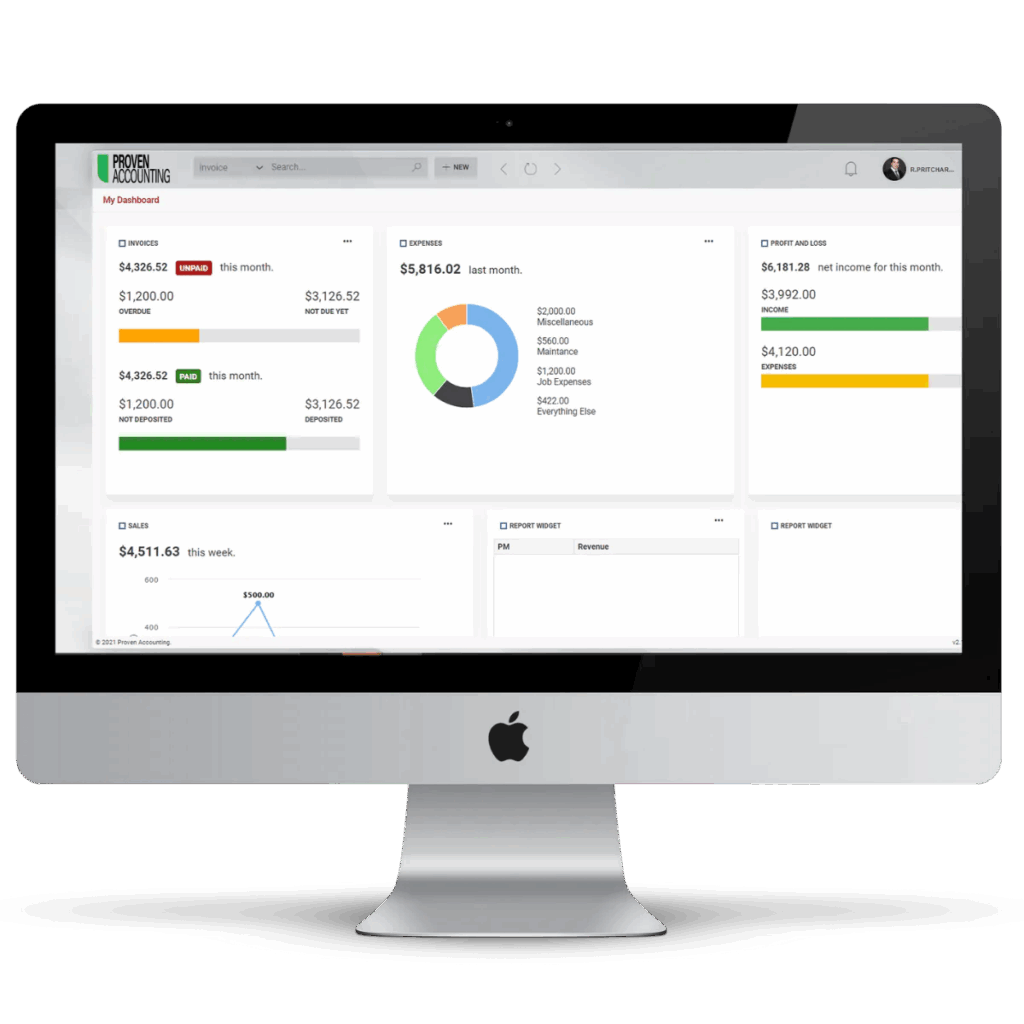
Source: PSA
Key Features:
- Advanced scheduling, dispatching, and job progress tracking
- Financial reporting, including profit/loss, forecasting, and payroll
- Equipment and inventory management across locations
- Multi-branch user access and permissions
- XactAnalysis integration for insurance job intake
Pros:
- Purpose-built for growing or multi-location restoration businesses
- Deep financial tools that help track job profitability
- Scalable infrastructure to manage large teams and complex workflows
Cons:
- Not beginner-friendly, expect a serious training phase
- High cost makes it a better fit for businesses over $2M in annual revenue
- Might feel “heavy” for firms focused only on mold remediation or water damage restoration
Ratings:
- Price: 2/5
- Usability: 3/5
- Features: 5/5
Is PSA the right fit for you? If your business has multiple branches or you’re struggling to unify your job tracking and financial reporting, PSA delivers a level of control you won’t get from lightweight CRMs. It’s one of the top platforms we see adopted by growing teams who are ready to level up from spreadsheets and clipboards.
JobNimbus

If your ideal CRM is something simple, visual, and won’t make your team cry during onboarding, JobNimbus might be the one. Originally built for roofers, it’s since evolved to serve other trades and restoration companies have taken notice.
At its core, JobNimbus is all about visual workflows. You get customizable pipelines that make it easy to track job stages like “Estimate Sent,” “Dry-Out Complete,” or “Final Invoice Sent.” It’s a great fit for owners who want to see everything at a glance, without drilling into a dozen tabs.
The system offers basic automation like sending a status update when a job is moved to a new stage and plays nicely with tools like QuickBooks, Google Calendar, and Zapier. But it does require some effort to tailor it for insurance-driven work. If you’re managing detailed claim documentation or moisture logs, you’ll likely need to build a few custom fields and workflows to make it work smoothly.
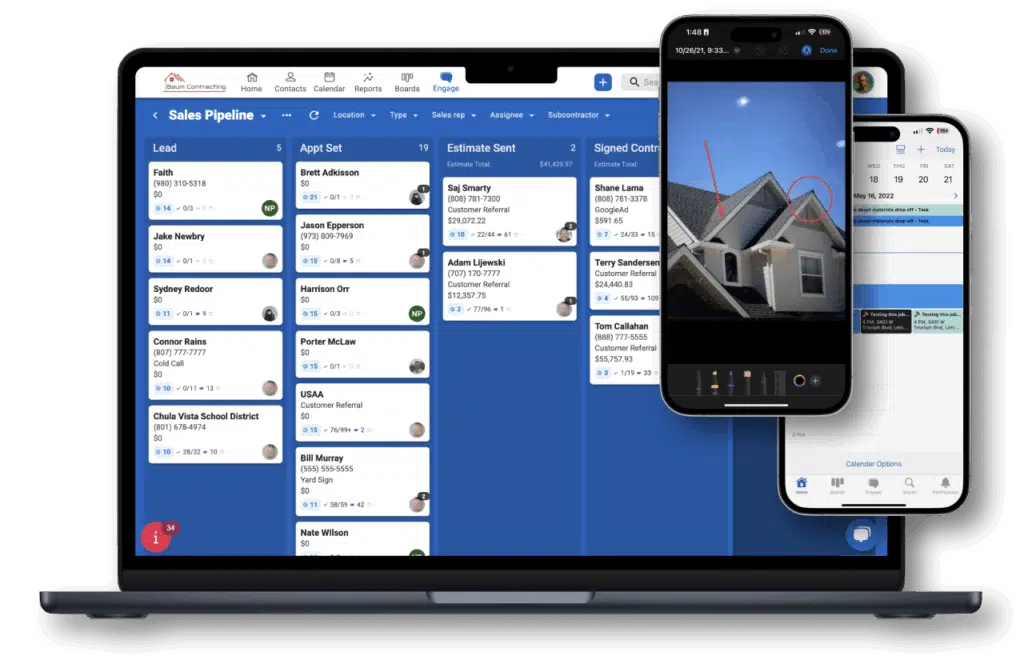
Source: JobNimbus
Key Features:
- Drag-and-drop job pipeline for visual progress tracking
- Basic automation: triggers for emails, status changes, and follow-ups
- Estimate and invoice tools with built-in tracking
- Integrations with QuickBooks, Google Calendar, and Zapier
- Custom fields to adapt workflows for restoration use
Pros:
- Extremely user-friendly, ideal for teams new to CRM tools
- Flexible enough to mimic restoration workflows
- Affordable pricing across multiple tiers
Cons:
- Not designed specifically as a restoration CRM software
- Lacks native support for Xactimate or claim-specific processes
- Advanced features like SMS, automation bundles, or storage may cost extra
Ratings:
- Price: 4/5
- Usability: 5/5
- Features: 3/5
Is JobNimbus the right fit for you? If you’re looking for a clean, flexible platform to manage your leads and projects, and you don’t mind tweaking it to work for mold remediation or water damage jobs, it can absolutely get the job done. It’s especially popular with companies just starting to digitize their processes or those who’ve had enough of clunky, overbuilt systems.
Want to compare JobNimbus head-to-head with niche restoration CRMs? We recommend checking out real-world reviews from platforms like G2 to see how it stacks up from a user perspective.
Housecall Pro

If most of your jobs are local, cash-based, and involve homeowners, not insurance adjusters, then Housecall Pro might be the CRM that finally replaces your paper calendar and a pile of handwritten invoices.
This tool is geared toward service businesses that need speed, ease, and customer convenience. It’s not a restoration CRM in the traditional sense, but it still covers a lot of ground for companies focused on straightforward scheduling and billing. The drag-and-drop dispatch board, client self-booking portal, and on-site payment processing make it a strong pick for restoration pros handling lower-volume, high-turnover work.
You can see User Ratings & Reviews on Software Advice, where Housecall Pro scores high for ease-of-use (4.7/5) and reliability across 2,800+ reviews
But here’s the catch: if your day revolves around claim forms, drying logs, or compliance audits, Housecall Pro might leave you improvising. There’s no built-in moisture tracking or insurance integrations. You’ll either need external tools or a lot of creativity to adapt it for complex restoration workflows.
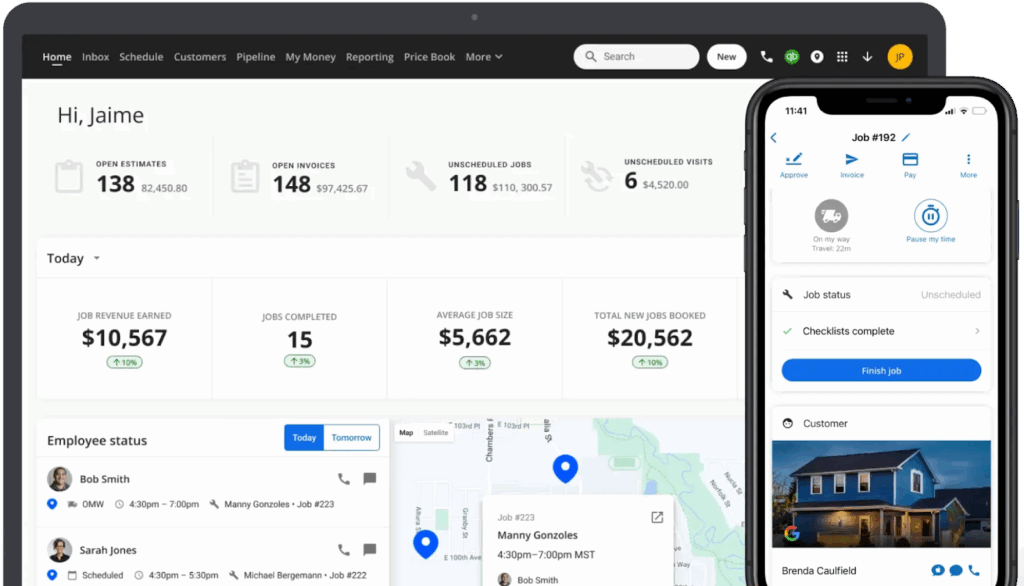
Source: Housecall Pro
Key Features:
- Online client booking and real-time job scheduling
- Mobile app with on-site invoicing and credit card payment support
- Automated marketing tools like postcard and email follow-ups
- Technician dispatch, task tracking, and service reminders
- Customer portal to review work, pay online, and rebook services
Pros:
- Quick to set up and easy for techs and admins alike
- Makes the homeowner experience seamless and professional
- Excellent for small teams with a direct-pay business model
Cons:
- No moisture logging or claim tracking functionality
- Lacks integration with platforms like Xactimate or Encircle
- Not ideal for larger teams or insurance-driven operations
Ratings:
- Price: 4/5
- Usability: 4/5
- Features: 3/5
Is Housecall Pro the right fit for you? If your business is more about speed, simplicity, and volume, and less about paperwork and insurance, then it can absolutely streamline your daily operations. Restoration companies that operate more like home service providers often appreciate its clean interface and consumer-first features. That said, teams running heavy water damage restoration or mold remediation projects may eventually outgrow it as compliance needs increase.
To explore additional use cases or compare Housecall Pro to insurance-ready options, review customer testimonials on Software Advice for firsthand feedback from similar companies.
ServiceTitan

If your restoration business is part of a larger operation, maybe you also run HVAC, plumbing, or electrical, then ServiceTitan might be the software that finally brings all of it into one unified system.
ServiceTitan wasn’t built for restoration companies specifically, but it’s loaded with features that multi-service firms crave. We’re talking advanced call tracking, field sales tools, team performance dashboards, and some of the most detailed marketing ROI reports in the game. If you’re serious about technician accountability, sales analytics, or ad spend tracking, this platform gives you visibility most CRMs can’t.
That said, if your core business is mold remediation or water damage restoration, and most of your jobs revolve around insurance claims, you’ll hit some friction. ServiceTitan lacks restoration-specific modules like moisture tracking, drying logs, or insurance claim syncing. It’s also one of the most expensive platforms out there, and the onboarding process is… let’s just say thorough.
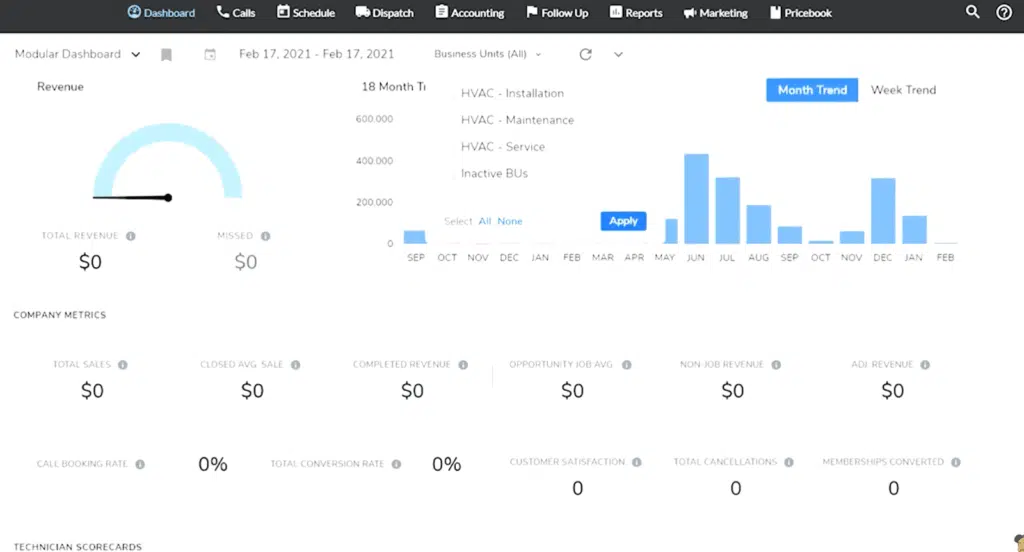
Source: ServiceTitan
Key Features:
- Marketing analytics and lead attribution from Google Ads to referral calls
- Technician sales tools and financing presentation in the field
- Advanced scheduling and GPS-based dispatching
- Call recording, CSR scripts, and booking scorecards
- Deep reporting dashboards across departments
Pros:
- Ideal for hybrid or multi-trade businesses that include restoration
- Top-tier marketing analytics and call tracking
- Built to scale with growing operations and field teams
Cons:
- No native support for restoration-specific needs like moisture logs or claims
- Expensive, pricing fits more with enterprise service models
- Long onboarding with a steep learning curve for smaller teams
Ratings:
- Price: 2/5
- Usability: 3/5
- Features: 4/5
Is ServiceTitan the right fit for you? If you’re running restoration as one piece of a bigger home service puzzle, then yes, it’s one of the most complete operations platforms available. But if you’re solely focused on CRM for water damage restoration or mold remediation, and most of your work flows through insurance, you may be paying for a lot of features you won’t use. At Restoration Inbound, we’ve seen it shine for multi-service pros and overwhelm niche-only companies. Make sure your structure matches its power before you dive in.
Want to explore how others are using it across verticals? Verified reviews at G2 give a detailed look into its fit by industry.
Jobber

If your idea of a CRM is “just give me something that actually works and doesn’t require a 3-hour tutorial,” Jobber might be the breath of fresh air you’ve been waiting for.
Jobber is all about simplicity. It’s built for small to mid-sized home service businesses that need to schedule jobs, send quotes, collect payments, and move on. For restoration companies handling cash jobs or light-volume service calls, it covers the basics beautifully. You can be up and running in a single day, no IT team, no week-long training.
Where it starts to wobble is in the details. This isn’t a platform made for insurance claims or compliance-heavy documentation. There’s no built-in support for moisture logs, equipment tracking, or job costing by service category. If your workflows lean on Xactimate, or you need to track every dehumidifier down to the hour, Jobber might feel more like a temporary fix than a long-term solution.
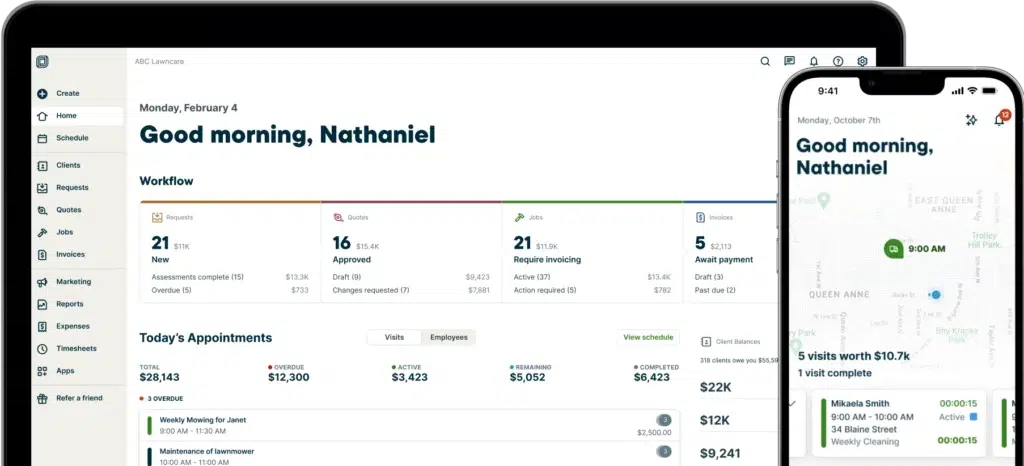
Source: Jobber
Key Features:
- Fast setup with intuitive dashboard and mobile app
- Online booking and automated appointment reminders
- Estimate, invoice, and payment tools baked in
- Basic reporting for time tracking, jobs, and expenses
- Client follow-up automation for reviews or repeat jobs
Pros:
- Extremely user-friendly, perfect for newer teams or solo operators
- Transparent pricing with multiple plan options
- Quick setup time with very little training required
Cons:
- Not built for restoration-specific workflows like drying logs or compliance reports
- Minimal integration ecosystem compared to niche CRMs
- Lacks the automation depth and insurance alignment of other platforms
Ratings:
- Price: 4/5
- Usability: 4/5
- Features: 3/5
Is Jobber the right fit for you? If you’re just starting out, or if you run a tight, straightforward team focused on smaller mold remediation or water damage restoration jobs without the insurance maze, Jobber is a solid entry point. It’s like the Honda Civic of CRMs: reliable, clean, and great for getting from A to B. But if you’re scaling fast or adding compliance-heavy services, you may outgrow it quickly.
Want a second opinion from real restoration pros? Capterra offers recent user reviews that spotlight how Jobber stacks up in the field.
Restoration CRM Feature Comparison
Still stuck between options? Here’s a quick-hit comparison table that shows how the top restoration CRMs stack up. Whether you’re running a large water damage operation, a mold remediation crew, or a growing multi-service firm, this breakdown will help you zero in on the platform that fits your real-world needs, not just the feature fluff.
| CRM | Ideal For | Insurance Integration | Mobile App | Compliance Support | Scheduling Tools | Pricing | Rating |
| Dash | Large teams, insurance jobs | ✅ Xactimate/XactAnalysis | ✅ Strong | ✅ IICRC-friendly | ✅ Advanced | $$$$ | ⭐ 4.0 |
| Albiware | Small to mid-size restorers | ⚠️ Limited native | ✅ Great | ⚠️ Basic HR/logs | ✅ Visual board | $$$ | ⭐ 4.0 |
| iRestore | Restoration-only teams | ⚠️ Partial | ✅ Smooth | ✅ Built-in HR tools | ✅ Moderate | $$ | ⭐ 3.7 |
| PSA Contractor | Multi-branch, full ERP setups | ✅ XactAnalysis | ✅ Enterprise | ✅ Deep analytics | ✅ High-volume | $$$ | ⭐ 4.2 |
| JobNimbus | Simpler pipelines, easy setup | ❌ None native | ✅ Solid | ❌ Requires custom | ✅ Drag-and-drop | $$$ | ⭐ 4.0 |
| Housecall Pro | Cash-based restoration firms | ❌ None native | ✅ Polished | ❌ Not included | ✅ Efficient | $$ | ⭐ 3.6 |
| ServiceTitan | Hybrid firms (HVAC + restoration) | ❌ None native | ✅ High-end | ❌ Not built-in | ✅ Smart routing | $$$ | ⭐ 3.7 |
| Jobber | Solo ops, small field teams | ❌ None native | ✅ Easy to use | ❌ Not included | ✅ Basic calendar | $ | ⭐ 3.5 |
Pricing key:
- $ = under $100/month
- $$ = $100 – $300/month
- $$$ = $300 – $500/month
- $$$$ = $500+/month
Latest available pricing (subject to change):
- Dash: $595/user/month (Capterra – Dash)
- Albiware: $60 – $100/user/month, $500/month minimum (Albiware Pricing)
- iRestore: $279 – $379/month depending on team size (iRestore Pricing)
- PSA Contractor: $325/month (Capterra – PSA)
- JobNimbus: $300/month (Capterra – JobNimbus)
- Housecall Pro: $59 – $299/month based on plan (Housecall Pro Pricing)
- ServiceTitan: $125 – $398/month (TrustRadius)
- Jobber: $29 – $149/user/month (Jobber Pricing)
Always confirm pricing directly with the vendor. Plans and terms may change based on your team size, features, and contract terms.
Need Help Choosing the Right CRM?
General vs. Industry-Specific CRMs
When it comes to choosing a restoration CRM, the temptation is real: “Why not just use HubSpot, Salesforce, or Monday.com?” After all, they’re sleek, popular, and you’ve probably heard your cousin’s marketing agency swear by them.
But here’s the thing, general CRMs aren’t built for the daily grind of mold remediation or water damage restoration. They don’t know what it’s like to document 42 drying fans, snap before-and-after photos in a flooded crawlspace, or upload a moisture log before an insurance adjuster has a meltdown.
That’s the tradeoff. General CRMs offer flexibility. You can customize pipelines, create task boards, and even track customer communication. But flexibility comes at a cost: setup time, plugins, and a fair bit of duct-tape thinking. You’ll spend more time trying to make it work than actually working. That’s time you could spend on conversion optimization strategies that actually support your systems.
Want proof? Capterra’s Zapier vs Monday.com comparison shows how even top-tier tools require extensive setup and workflows to mirror restoration needs
Industry-specific platforms like Dash, PSA, or iRestore skip the guesswork. They come preloaded with the tools you actually use: Xactimate integration, moisture tracking, equipment logs, job costing, and compliance features tailored to your space. If you’re serious about growing your restoration business and want your CRM to fit like a glove instead of a workaround, this is the direction most pros go.
If you’re still figuring out which direction is best for your team, our CRM and lead generation consulting helps business owners match tech to workflow, not the other way around.
What About Project Management Tools?
We hear it a lot: “Can’t I just use Trello or Monday.com instead of a restoration CRM?” Sure, if your business model is more sticky notes than structure.
General project management tools like Trello, Asana, and ClickUp are great for task lists, deadlines, and quick visuals. They’re flexible, clean, and even fun to use. But once you step into the world of mold remediation CRM software or water damage restoration workflows, that flexibility becomes your full-time job. You’ll end up duct-taping task boards, Zapier hacks, and spreadsheet backups just to track a moisture reading.
That’s the catch. These tools can mimic the surface of a CRM for restoration companies, but they don’t come with the real bones: Xactimate syncing, equipment tracking, job costing, or compliance documentation. If your team is scaling or working inside insurance workflows, the gap only gets wider.
Ideal for quick wins and visual task tracking? Project management tools are cool. But as this ClickUp vs Trello comparison shows, when your restoration business demands depth like field documentation, compliance, and insurance integrations – you’ll start patching workarounds faster than you can hit “complete.”
If you’re using something like Trello now and it’s “working enough,” that’s fine, for now. But the second you add techs, jobs, or claim volume, you’ll spend more time managing your PM tool than your actual jobs.
How to Choose a Restoration CRM (2025 Guide)
Choosing the right restoration CRM is like choosing the right truck for your crew. It’s not about the shiny features, it’s about whether it gets the job done without breaking down under pressure. And in 2025, with tighter margins and higher expectations, choosing wrong can cost you more than just time.
So before you commit, here’s what actually matters:
1. Your Business Size & Complexity
- Small team or solo operator? Focus on CRMs like Jobber or JobNimbus. They’re light, fast, and won’t bury you in features you don’t need.
- Larger or multi-branch team? You’ll want something like PSA or Dash that can handle dispatching, financials, and compliance under one roof.
2. Your Workflow: Insurance vs. Direct Pay
- If your day-to-day revolves around adjusters, claim paperwork, and drying logs, generic platforms will burn you out.
- Prioritize CRM software for water damage restoration and mold remediation that includes Xactimate integration, job costing, and audit-ready reporting.
3. Mobile Functionality
- Your team is in the field. Can they snap photos, upload notes, and log readings from the job site?
- If not, you’re doubling your admin time back at the office, and probably dropping details along the way.
4. Integration Ecosystem
- Make sure the CRM connects with what you’re already using: QuickBooks, Xactimate, Encircle, Zapier, even your VoIP or call tracking tools.
- CRMs like Albiware, JobNimbus, and PSA shine here, but check compatibility before signing anything.
5. Support, Onboarding & Learning Curve
- Some systems (like Dash or ServiceTitan) pack a punch, but come with a ramp-up period.
- Look for CRMs with solid onboarding resources, live chat, and restoration-specific training. Don’t underestimate this if you’re switching from spreadsheets.
Want a deeper evaluation matrix? This 2025 CRM Buyer’s Guide from CRM Switch provides a step‑by‑step framework for evaluating complex tools—and you can adapt the same process to restoration‑specific platforms.
Need help navigating the tech stack? Our team has helped dozens of restoration companies match their CRM to their team structure, workflow, and growth plans. You can see how we approach that through our restoration lead generation systems that are built to scale with the right tools.
Get an Expert Recommendation, Not a Sales Pitch
How Restoration Inbound Can Help
Picking the right restoration CRM is just the beginning. The real challenge? Getting it to actually work with your business – your workflows, your team, your lead flow, your goals. That’s where we come in.
At Restoration Inbound, we don’t just hand you a list of tools and wish you luck. We work with CRM for mold remediation and water damage restoration companies every day. We’ve helped dozens of owners cut tech waste, streamline sales processes, and actually use the software they’re paying for.
Need help integrating your CRM for restoration companies with your website, PPC campaigns, or lead intake system? We do that. Not sure whether to choose Dash, Albiware, or JobNimbus? We’ll walk you through what makes sense based on how your business runs, not just what’s trendy.
As Skip Jankoski from Purified Environments put it, working with us delivered “the most effective and profoundly positive return on investment.”
You can find more real-world feedback like that on our restoration marketing reviews page.
If you’re serious about growth and want a restoration CRM software setup that doesn’t just check boxes but actually fuels your pipeline, we’d love to be your go-to partner.
FAQs About Restoration CRMs
1. What is the best CRM for mold remediation businesses?
If you’re running a mold remediation company that deals with documentation, compliance, and customer communication daily, you’ll want a CRM built for the field. iRestore and Albiware are strong options. iRestore offers field-friendly tools with built-in HR tracking, while Albiware gives you a modern UI and automation that scales well with growing teams.
The “best” CRM depends on your job volume, insurance workflows, and how tech-savvy your team is, but avoid generic tools that don’t understand the pace or precision needed in mold remediation.
2. Which restoration CRM integrates with Xactimate?
Dash (by Next Gear Solutions) and PSA Restoration Contractor are your top contenders if Xactimate integration is a must. Both allow for seamless import of estimates, job statuses, and claim updates, which can seriously reduce admin time and improve accuracy when dealing with insurance.
Albiware also offers partial integration through Zapier and APIs, but for native compatibility, Dash and PSA lead the pack.
3. Are there CRMs made just for water damage restoration?
Yes, several CRM for water damage restoration platforms are built with drying logs, equipment tracking, and insurance processes in mind. Dash, PSA, and iRestore are purpose-built with water mitigation in focus. These tools let you manage everything from field documentation to compliance reporting without relying on a stack of disconnected apps.
4. What’s the easiest CRM to implement in a small restoration company?
If you’re just getting started or upgrading from pen and paper, look at Jobber or JobNimbus. Both offer intuitive interfaces, clean mobile apps, and flexible pricing. They’re not built exclusively as restoration CRM software, but they’re simple to customize and work great for small teams or new business owners who want to digitize scheduling and client communication.
5. Can I use general software like Trello or Monday.com for restoration?
You can, but you’ll eventually outgrow it. Tools like Trello or Monday.com are solid for task management but lack critical restoration-specific functions like Xactimate syncing, moisture tracking, and insurance-ready reporting. If your jobs involve documentation or insurance claims, you’ll end up layering too many tools just to stay organized.
Project management software is great for internal collaboration, but for fieldwork and growth? A dedicated CRM for restoration companies is the better move.